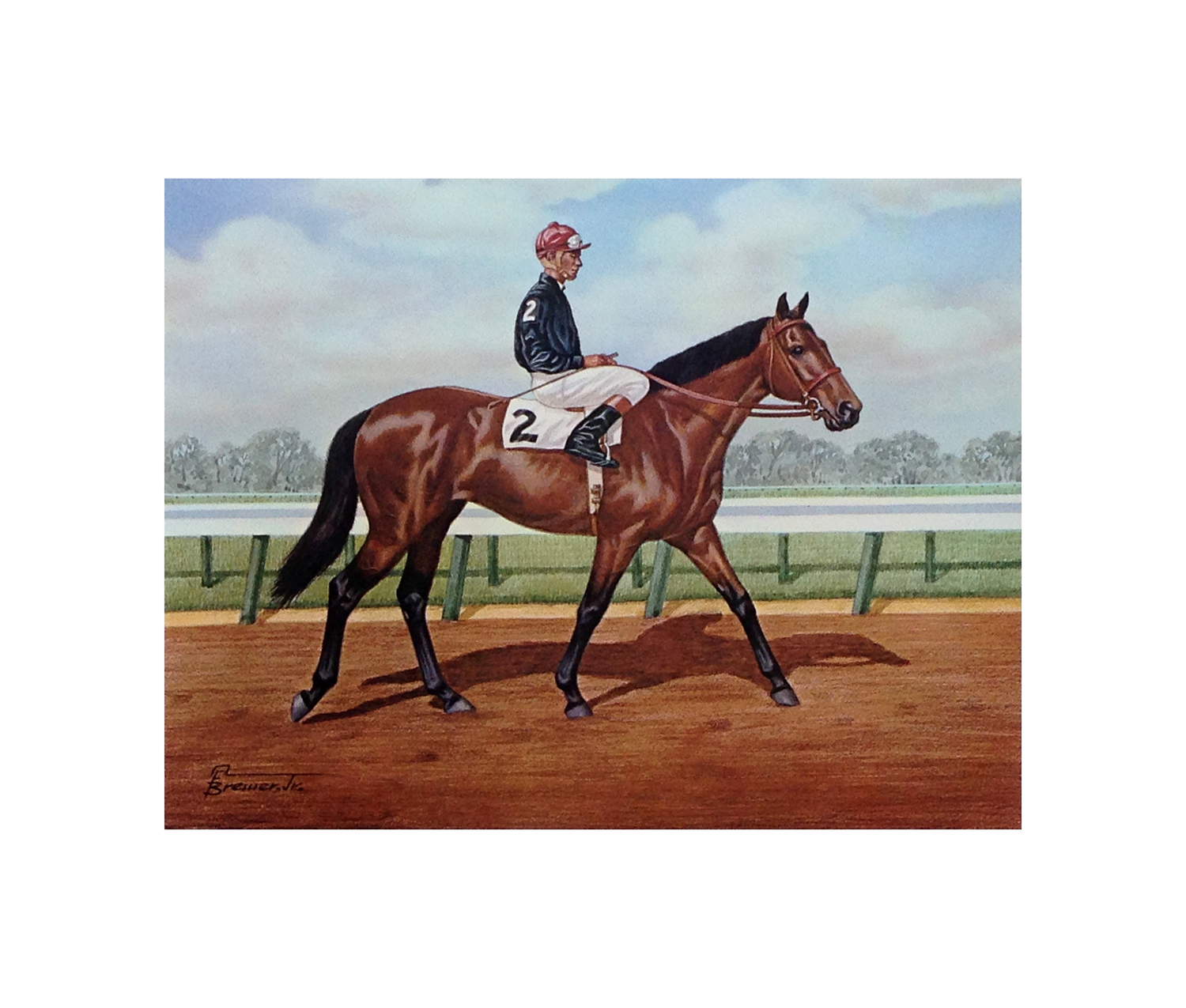Print Size 17″ X 22″, Image Size 11″ X 14″
This print has been in storage since 1967 and has slight discolorations around the print border which does not distract from the beauty of the print and would be easily covered up when matted and framed.
BUCKPASSER, (1963–1978) was an American-bred Thoroughbred racehorse that won 9 of his 11 race starts for international record winnings for a two-year-old of $586,090. He was leading broodmare sire in 1983, 1984, and 1989.
Buckpasser was a bay colt that was bred and owned by Ogden Phipps and foaled at Claiborne Farm in Paris, Kentucky. He was by the Horse of the Year-winner Tom Fool, and his dam was the stakes-winning mare Busanda, by the Triple Crown-winner War Admiral. Busanda’s second dam was the Blue Hen broodmare La Troienne (FR). He was a half-brother to several other horses that included the stakes-winners Bupers (won $221,688) and Bureaucracy ($156,635). Buckpasser was inbred in the fourth generation (4m x 4f) to the French racehorse and influential sire Teddy.
Racing official Dr. Manual Gilman said of him, “Generally, every horse has about a hundred faults of conformation. I would defy anybody to pick a flaw in Buckpasser.” Renowned horse painter Richard Stone Reeves said, “Buckpasser was the most perfectly proportioned Thoroughbred I have ever seen.” Only two horses, Secretariat and Affirmed, have since been “in a class with Buckpasser”.
Buckpasser had two trainers, both since elected to the U.S. Racing Hall of Fame. Bill Winfrey began his training, and when he retired, Eddie Neloy took over and prepared Buckpasser for his three-year-old season.
Buckpasser’s first race start was on May 13, 1965, in which he ran a poor fourth. It was the only time he did not place. When Buckpasser ran in the Flamingo Stakes, the race was declared a nonwagering event, forever after called the “Chicken” Flamingo.
After his two-year-old season and spring, he was placed at the top of the Experimental Free Handicap with 126 pounds. Buckpasser developed a quarter crack that kept him out of the 1966 Kentucky Derby, as well as the Preakness and Belmont Stakes. It took almost three months for the crack to heal.
In Chicago’s Arlington Classic, Kauai King ran against the strenuous protests of his trainer. He broke down and was retired, while Buckpasser won the race, setting a new world record for a mile with a time of 1:32 3/5. This record stood for two years until Dr. Fager broke it in 1968, running 1:32 1/5. In 1989, Buckpasser’s grandson, Hall of Fame Champion Easy Goer, ran a mile in 1:32 2/5.
Buckpasser won 15 consecutive races that included the American Derby (breaking the track record), the Chicago Stakes, the Brooklyn Derby, the Woodward Stakes, the Travers Stakes, the Malibu Stakes, the Brooklyn Handicap, the Lawrence Realization Stakes, and the two-mile-long Jockey Club Gold Cup. With 13 victories as a three-year-old, Buckpasser became the first horse to earn more than $1 million before the age of four. He was named the 1966 American Horse of the Year.
His four-year-old season commenced with a win in the San Fernando Stakes. Another quarter crack developed in Buckpasser’s off (right) fore hoof, and he did not race for 4½ months. When he returned, he scored his 15th consecutive victory in the Metropolitan Mile. On June 17, 1967, Buckpasser’s winning streak ended with his first and only attempt at racing on grass. He finished third to stablemate Poker in the Bowling Green Handicap at Aqueduct Racetrack. Assagai, the 1966 turf-course champion, finished second. As The Blood-Horse said in its July 24, 1967, issue: “Never had so many people had so many immunization shots in order to stay home and watch the Suburban Handicap on Independence Day.” Three reasons were advanced for his defeat: turf, shoes, and weight. Buckpasser also ran that day with his head held in an uncommon way, slightly sideways. No one has ever understood why.
He won 25 of his 31 races, including a 15-race winning streak, earned five Eclipse Awards between 1965 and 1967, and was inducted to the Horse Racing Hall of Fame in 1970.
ORIGINAL EDITION SIZE: 200

